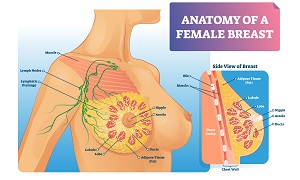What is Breast Cancer?
Breast cancer is one of the most prevalent forms of cancer affecting women worldwide, with millions of diagnoses made each year. While it primarily occurs in women, men are also at risk, though the incidence is significantly lower. The complexity of breast cancer arises from its various types, which can differ in terms of biology, behavior, and treatment response. This disease develops when cells in the breast tissue grow uncontrollably, often forming a mass known as a tumor.
Breast cancer can range from localized tumors that are easily treatable to advanced stages that may have spread to other parts of the body. Early detection has been proven to significantly improve survival rates and treatment outcomes, making awareness and regular screening crucial.
Anatomy of the Breast
In order to understand Breast Cancer, it will be important to understand the anatomy of the Breast.
Breasts are specialized organs, located on the anterior (front) of the chest wall. The breast are more developed in females as compared to males. Breast contain a lot of glands that grow & develop during puberty & maturation. For promoting growth & development in females, hormones such as Oestrogen & Progesterone play an important role.
Many changes may occur in breast during pregnancy to prepare for the baby and produce milk
The components of Breast are:
Types of Breast Cancer
Breast cancer is categorized into various types based on the origin and characteristics of the tumors. The two most common forms are:
Invasive Ductal Carcinoma (IDC): This type begins in the milk ducts and invades surrounding breast tissue. It accounts for about 80% of all breast cancer cases.
Invasive Lobular Carcinoma (ILC): This cancer starts in the lobules, which produce milk, and can spread to nearby tissues. It is less common than IDC.
Other types include:
- Ductal Carcinoma In Situ (DCIS): A non-invasive condition where abnormal cells are found in the duct lining but have not spread to surrounding tissues.
- Triple-Negative Breast Cancer: A more aggressive subtype that lacks three common receptors, making it more challenging to treat.
- HER2-Positive Breast Cancer: This form has higher levels of the HER2 protein, which promotes the growth of cancer cells.
Signs & symptoms of breast cancer
The signs and symptoms of breast cancer can vary, but some common indicators include:
- A noticeable lump or mass in the breast or underarm area.
- Changes in breast size or shape.
- Alterations in the skin texture, such as dimpling or puckering.
- Unexplained changes in the nipple, including discharge or inversion.
- Swelling or redness in or near the breast.
It is important to note that not all lumps are cancerous; however, any changes should be discussed with a healthcare professional.
Causes & risk factors of Breast Cancer
Understanding the risk factors associated with breast cancer can help individuals take proactive measures. While some factors cannot be changed, awareness is key:
- Gender: Women are significantly more likely to develop breast cancer than men.
- Age: The risk increases with age, particularly after age 55.
- Family History: A history of breast cancer in immediate relatives can elevate risk.
- Genetic Mutations: Certain inherited gene mutations can increase susceptibility to breast cancer.
- Lifestyle Factors: Factors such as obesity, alcohol consumption, and lack of physical activity have been linked to a higher risk.
- Reproductive History: Early menstruation, late menopause, having no children, or having children after age 30 can influence risk.
Diagnosis of Breast Cancer
Early diagnosis is crucial for effective treatment. The diagnostic process typically involves several steps:
Physical Examination: A healthcare provider will perform a thorough breast examination, checking for lumps or other abnormalities.
Imaging Tests:
- Mammography: This X-ray of the breast is the most common screening tool and can detect tumors that are too small to be felt.
- Ultrasound: Often used to evaluate suspicious areas identified in a mammogram.
- Magnetic Resonance Imaging (MRI): May be recommended for further evaluation or in high-risk patients.
Biopsy: If abnormalities are detected, a biopsy is performed to obtain a sample of breast tissue. This sample is analyzed to determine the presence of cancer cells and their characteristics.
Staging: If cancer is diagnosed, staging determines the extent of the disease, which is crucial for developing an effective treatment plan. Stages range from I (localized) to IV (advanced with metastasis).
Treatment options for Breast Cancer
The treatment of breast cancer varies based on the type, stage, and individual patient factors. Common treatment modalities include:
Surgery:
- Lumpectomy: Removal of the tumor and a small margin of surrounding tissue.
- Mastectomy: Removal of one or both breasts, depending on the extent of the disease.
Radiation The*rapy: This treatment uses high-energy waves to target and kill cancer cells, often used after surgery to reduce the risk of recurrence.
Systemic The*rapy: This can include various approaches:
- Chemothe*rapy: Uses drugs to kill cancer cells or stop their growth.
- Hormonal The*rapy: Blocks hormones that fuel certain types of breast cancer, typically recommended for hormone-receptor-positive cancers.
- Targeted The*rapy: Focuses on specific characteristics of cancer cells, such as HER2 status, to improve treatment efficacy.
Clinical Trials: Participating in clinical trials may provide access to cutting-edge therapies that are not widely available.

